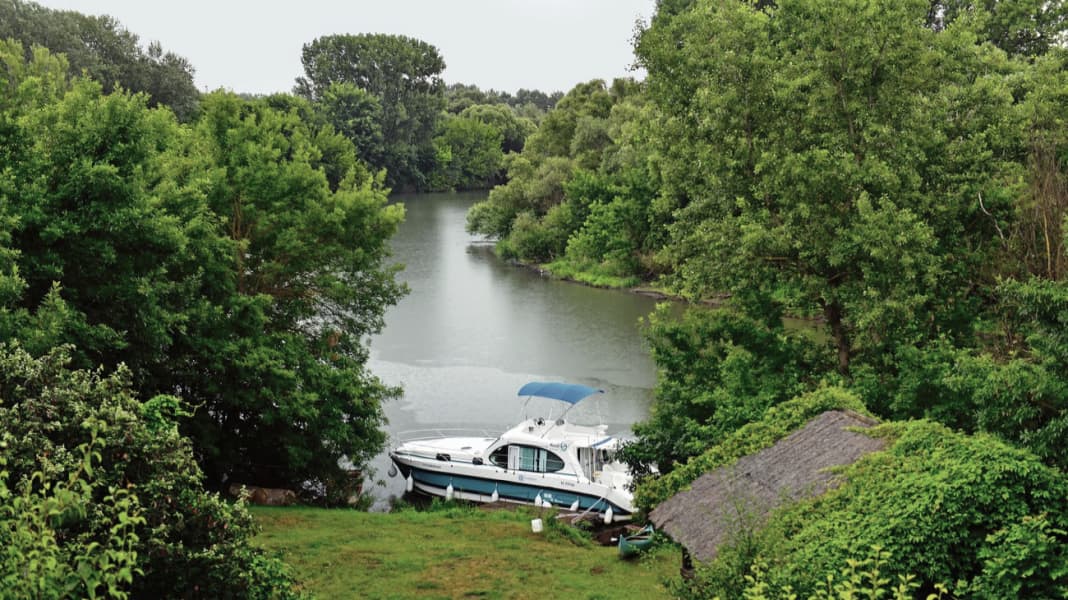
Our houseboat purrs quietly uphill. Old, tall deciduous trees line the lazy river on both banks. Dense greenery stretches right down to the water's edge. Swamp flowers bloom on floating islands of dead giant trees. A snake slithers into the water and takes flight, birds take flight from a great distance. It doesn't seem natural that people in large boats should enter this remote paradise. We are completely alone on the river, which is up to a hundred metres wide, one bend following the next. We sail for hours through a green corridor. Where are we anyway? In the endless expanses of South America, on a tributary of the Amazon perhaps?
Far from it! We are on the Bodrog, just twelve kilometres away from the geometric centre of Europe. This is not in Paris or Vienna, but in the village of Tállya in north-east Hungary. The area is better known as the wine-growing region of Tokaj. The most famous and most expensive grape juice in the world thrives here. Tokaj is also known as the "king of wines and wine of kings". It was not only introduced to the Russian Tsar's palace, but also to the court of the French Sun King Louis XIV. Even the loud protests of the French winegrowers did not help: monarchs drink Tokay. Even today, Europe's nobility are regular customers.
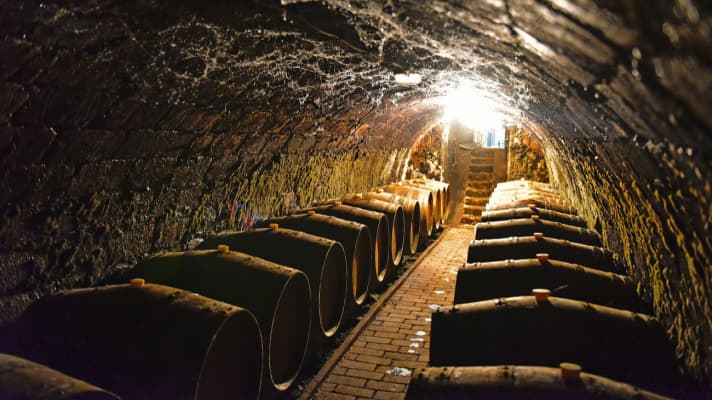
A river cruise on the Bodrog is therefore always a journey to the winegrowers who produce this unique wine. At around one hundred kilometres long, the Bodrog is a short river. It is formed by the confluence of the Ondava from Slovakia and the Latorica from Ukraine. At the foot of the Tokaj vineyard, the Bodrog flows into the Tisza. The latter flows southwards parallel to the Danube and after almost 1000 kilometres flows into the Serbian Novi Sad as the longest river. The Tisza and Bodrog have always been navigable. The fact that we can travel here so comfortably today is thanks to the houseboat charter company Nicols, which stationed an entire fleet of boats in the wine metropolis of Tokaj in 2020. It is located on the Bodrog, about two kilometres north of where it flows into the Tisza. Cruises are possible on both rivers. On the recommendation of the Hungarian base manager, we decide in favour of the Bodrog because the river runs through the Tokaj wine-growing region.
After taking over our new Estivale Quattro boat and stowing our provisions, we first head to the old town centre of Tokaj. This is a must. On the main square next to the Roman Catholic church stands the statue of Bacchus, behind which is the entrance to the Rákóczi wine cellar, the largest and most famous in the wine-growing region. Up to 20,000 hectolitres of Tokaj are stored here in kilometres of underground tunnels. The perfect place to find out why this wine is so sinfully sweet and expensive. "Tokay only exists in this wine-growing region," explained the young oenologist Kathryn Aronsohn. "We produce dry, semi-dry, semi-sweet and sweet wines from the three grape varieties Furmint, Gelber Muskateller and Lindenblättriger." She pours a tiny sample of each and points to the corresponding bottles on the shelf. Suddenly I feel dizzy - but not from the alcohol, but from the price tag: the sweet Tokaj Eszencia from the 1999 vintage is available from 160,000 forints for a half-litre bottle, which is a whopping 440 euros.
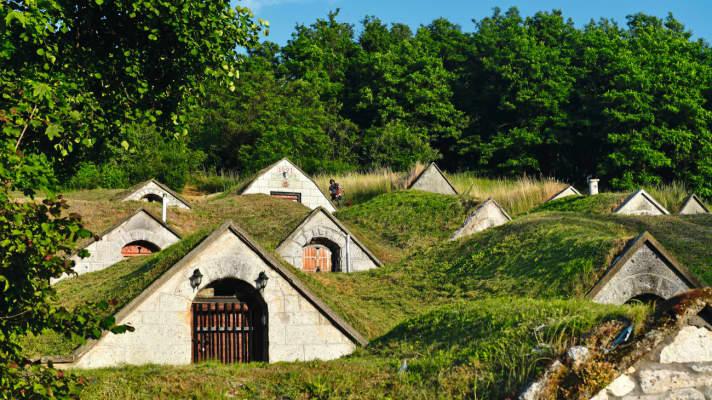
The process for producing sweet Tokay is labour-intensive and risky. It is not the plump grapes that are harvested at the end of the summer, but the raisin-like shrivelled berries much later - but only those that are affected by mould. Noble rot on the vine is a natural concentration of must that depends on many external conditions. In outstanding years, unique wines are produced that are among the best in the world. As the drop caresses her tongue, Kathryn adds with her eyes closed: "This is the sweet blood of the Magyars."
Back on board, we start with Tokaji Furmint in the fridge, but not the sweet ones for 440 euros, but the dry ones for four euros a bottle. Navigation is easy. There are only a few fairway buoys. As is the case everywhere else, you should keep to the outer radii of strongly meandering rivers. Only the cable ferries take some getting used to. But communication is simple. If the ferry is moored on the bank and displays a large white flag facing the river, the cable is lowered and shipping is allowed to pass. Seven kilometres to the north, the green corridor opens up on the port side, revealing a village with single-storey detached houses and large vegetable gardens. It is called Bodrogkisfalud. We discover a new, very solid floating pontoon and moor up. No harbour master charges a fee.
Without realising it, we enter historical territory and walk a few steps to the Dereszla wine cellar. The original owner was King Sigismund (1368-1437) of Hungary and Croatia, who also became King of Bohemia in 1419 and Roman-German Emperor from 1433 until his death. The three tunnels of the Kaiser-Keller are still in use today. The modern Dereszla Bistró is located right next to the pier. Don't be put off by the name. It is a noble restaurant with excellent Dereszla wines. Only the prices are reminiscent of a bistro( www.dereszla.com ).
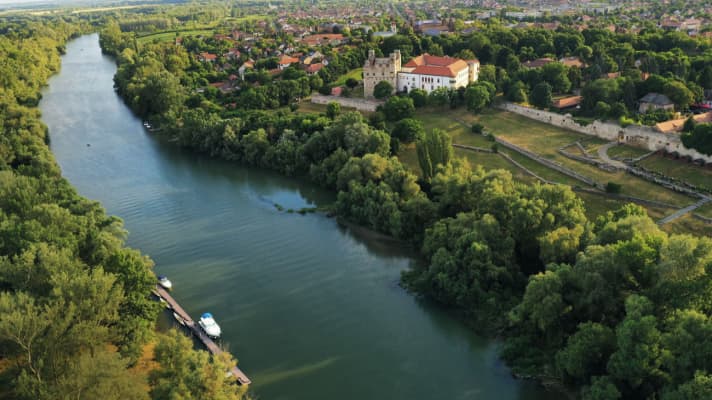
Our Estivale Quattro takes us further upstream. After 23 kilometres of solitude, we stop in Bodrogolaszi, which means "Italy on the Bodrog". There is a village church from the 15th century and a castle to see, which is being renovated and is therefore not accessible. Another hour later, we reach the small town of Sárospatak in the evening. Slovakia begins just a few kilometres to the north, with the border to Ukraine to the east. The town is famous for the fortress of the Hungarian nobleman Georg Rákóczi (1593-1648), the prince of Transylvania, which belonged to Hungary at the time. Prince Rákóczi is still honoured today because he enforced religious freedom in Hungary. Under his rule, persecuted Protestants came from Austria and Swabia. In Sárospatak, as in all the other places where we moored, there is a new, solidly built and comfortably equipped floating dock. There is enough space for two charter boats to go alongside one after the other. There is electricity and water on the jetty and the gate can be opened with a combination of numbers. The jetties have been specially built so that the charter boats can moor safely.
As soon as we have moored, we are expected. A young man greets us in fluent German: "I'm winegrower Stefan Götz. Get in, we're only travelling three kilometres and I'll show you something you've never seen before." In the village of Hercegkút, whose German name is Trautsondorf, we park in front of the church. All around, I read the signs in German: Kindergarten, primary school, cultural centre.
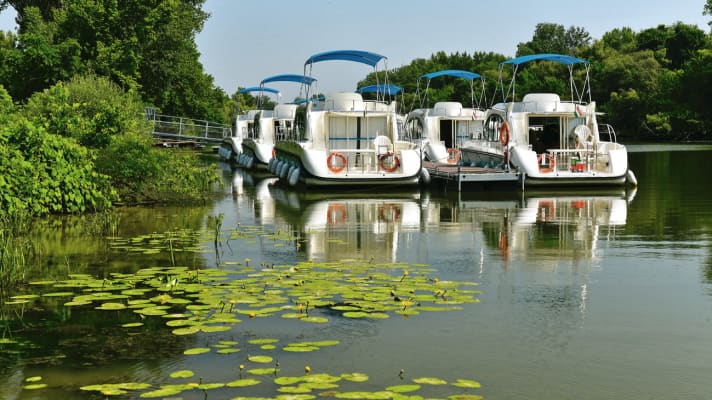
"Swabians came here around 1750 and founded three villages. They learnt winegrowing from the Hungarians and most of them became winegrowers. German is still spoken today," he explains. They lived in harmony with their neighbours for a long time. Although all German was banned in 1945, the language has returned since the political change in 1990. "And now I'll show you our UNESCO World Heritage Site," says Stefan proudly: around one hundred low houses nestle against a vineyard and lead under grass roofs into its interior - like a fantasy world from Lord of the Rings.
Stefan's house bears his family name. "When our ancestors arrived here, they were allowed to chisel a living space into the sand-lime brick and build a façade with a door and window in front of it. Only when they had cleared a piece of forest and grown grain or wine were they allowed to build a proper house," he explains. Later, the cave houses became wine cellars when the families dug deep tunnels into the mountain. Today, the Götz family's winery is the largest wine-growing operation here( www.gotzpinceszet.hu/de ).It's already too late to eat anything in Sárospatak. But Stefan goes to the cellar and brings a crate of Tokay. He takes a loaf of white bread and a large side of bacon from a larder, from which he cuts off a strip as long as a hussar's sabre. "These are the staples here. Have a nice evening!"
In the morning, we are faced with the decision of either cycling another 13 kilometres uphill to the Slovakian border or back to Tokaj and a little further along the Tisza. We decide in favour of the descent, also to get to know the other river. The 35 kilometres downhill to Tokaj can be completed in three hours. But we are unexpectedly stopped about halfway down: In a bend at kilometre 20.5, a friendly man waves us over and tells us to throw him the lines. The mooring is homemade and very wobbly. But the man manages to secure our charter boat. His name is László Kvaszinger and he is the owner of the Kvaszinger vineyard. The Kvaszinger family had also immigrated from Germany. His great-grandfather worked as an estate manager on the vineyard of a Hungarian baron, who blew all his cash playing cards one drunken night. In order to get his money back, he sold four hectares of his vineyard to the German family. Today, the Kvaszinger wines are among the best in the region( www.kvaszinger.hu ).
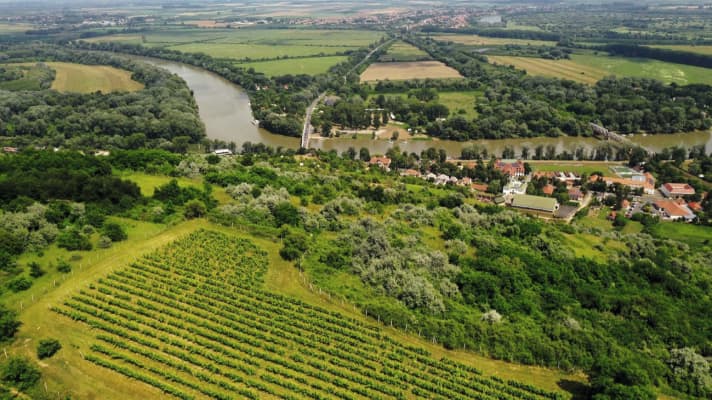
After a stopover at our charter base in Tokaj, we set off on our cruise on the Tisza. Just two kilometres downhill, we can already see the largest tributary of the Danube. As it looks more interesting upstream, we decide to head north-east towards Ukraine. However, there are still 82 kilometres to go, which we won't manage in the remaining two days. After five kilometres upstream, we see a very nice fish restaurant right by the water in the village of Timar, but unfortunately it is closed. So we navigate further upstream through the lonely landscape and reach the small settlement of Tiszabercel after another two and a half hours of travelling. We moor in front of the Bettlerhafen restaurant. The waiter helps us tie up. The restaurant has the charm of a snack bar, but it's a lovely place to sit under old trees on the riverbank.
The young waiter recommends a spicy Hungarian fish soup, accompanied by dry Tokaj. What more could you want? So that the return journey to the charter base is not too stressful, we motor downstream towards Tokaj for as long as we can see after dinner. In the last light we moor in Timar in front of the closed fish restaurant. The next day, we only have the last stretch to Tokaj and the Bodrog to the charter base. Our plane takes off in the evening. But Hungary will remain a sweet memory - the Tokaj will never be forgotten.
Need more information? The travelogue "The blood of the Magyars" can be found with more pictures and a service section in BOOTE issue 03/2022 - available at newsstands since 16 January 2022 or online at Delius Klasing Shop.

